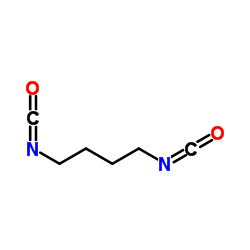Polyisocyanates are especially usefull in human health applications. However, these applications are of course very strict and should enhance human health instead of affecting it. For biomedical applications it is important using a very high purity product in order to exclude toxic impurities, starting materials, or catalytic reagents. [1] Furhtermore the used materials should not release any toxic products upon degradation. The next table gives an overiew of hard segment monomeric isocyanates and their products created when degrading.
| Monomer | Chemical structure | Degradation remarks | Reference |
|---|---|---|---|
| BDI
(butane diisocyanate) |
 |
Results in putrescine, a naturally occuring product which enhances cell growth and differentiation. This effect is advantageous for tissue engineering, regeneration, and other biomedical applications | [2] |
| HDI
(hexamethylene diisocyanate) |
 |
Upon degradation diamines are released, a product which is noted to be toxic for several human organs such as the liver and kidney. | [3] |
| IPDI
(Isophorone diisocyanate) |
 |
The degradtion product of IPDI is less toxic than aromatic isocayanates. | [3] |
| LDI
(lysine diisocyanate) |
 |
Upon degradation LDI would degrade into lysine, a non-toxic by-product. | [3] |
| MDI
(methylenebis (phenyl isosocyanate)) |
 |
Toxic aromatic diamine degradation products | [3] |
| TDI
(toluene diisocyanate) |
 |
Like other other aromatic diisocyanates TDI has been noted to release aromatic diamines, a toxic degradation product known to stimulate carcigogenesis and mutagenesis. | [4] |
Reference table
[1] Severian Dumitriu, Valentin I. Popa, CRC Press, 2013, Pylermic biomaterials: structure and function, Volume 1.
[2] J. Guan, M. S. Sacks, E. J. Beckman, and W. R. Wagner, Biomaterials 2004, 25, 85
[3] Cooper, S. L., & Guan, J. (2016). Advances in polyurethane biomaterials. Duxford: Woodhead Publishing.
[4] Jeffrey O. Hollinger, 2005, CRC Press, An introduction to biomaterials.

